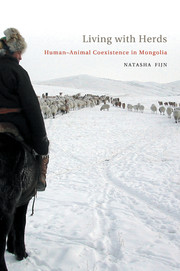Book contents
- Frontmatter
- Contents
- Lists of Plates, Figures, Maps, Tables, and Online Video Segments
- Glossary
- Acknowledgments
- LIVING WITH HERDS
- PART ONE CROSSING BOUNDARIES
- PROLOGUE: LIFE IN THE KHANGAI MOUNTAINS
- 1 INTRODUCTION
- 2 A MONGOLIAN ETHO-ETHNOGRAPHY
- PART TWO THE SOCIAL HERD
- PART THREE LIVING WITH HERDS
- Appendix
- References
- Index
- Plate section
PROLOGUE: LIFE IN THE KHANGAI MOUNTAINS
from PART ONE - CROSSING BOUNDARIES
Published online by Cambridge University Press: 03 May 2011
- Frontmatter
- Contents
- Lists of Plates, Figures, Maps, Tables, and Online Video Segments
- Glossary
- Acknowledgments
- LIVING WITH HERDS
- PART ONE CROSSING BOUNDARIES
- PROLOGUE: LIFE IN THE KHANGAI MOUNTAINS
- 1 INTRODUCTION
- 2 A MONGOLIAN ETHO-ETHNOGRAPHY
- PART TWO THE SOCIAL HERD
- PART THREE LIVING WITH HERDS
- Appendix
- References
- Index
- Plate section
Summary
Farming and city-building peoples have always looked down on nomads as “primitive”…but this does not mean that nomads have reciprocated by looking up to the city and farm. Far from it. There is a strong tradition among nomads that they are people who have made themselves free from the drudgery of the peasant and the shut-in life of the city dweller.
(Lattimore 1962: 34)FIRST IMPRESSIONS OF MONGOLIA
I could see the Soviet influence on the buildings in Mongolia, as a former satellite state of the Soviet Union. The Mongolian capital's expansive main square was flanked by parliament on one side and a drama theatre with an imposing façade and huge concrete columns on another. Every drab apartment block had the same basic design with thick double doors and double-glazed windows. This environment was very different from my expectations of a Mongolia with no locks on brightly painted ger doors and sparse, expansive grasslands.
My first few weeks in Mongolia in November 2004 were isolating and claustrophobic. The contrast between the below-freezing temperatures outside and the intense central heating inside gave me a feeling of suffocation. I suffered through episodes of feverish sweating from a terrible flu that developed soon after my arrival and was sure my fever was heightened by the fluctuating temperature changes.
- Type
- Chapter
- Information
- Living with HerdsHuman-Animal Coexistence in Mongolia, pp. 3 - 16Publisher: Cambridge University PressPrint publication year: 2011



